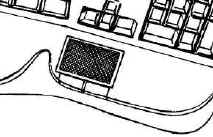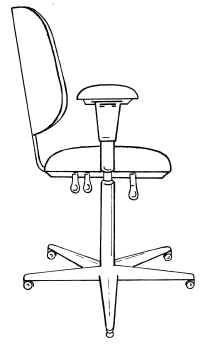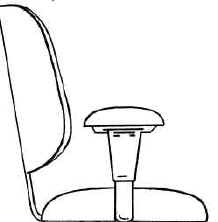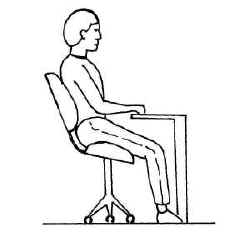Your
Computer Workstation
Dan MacLeod
www.danmacleod.com
June 10, 2002
Before reading this, make sure you understand the
basic principles of ergonomics on which this is based. It is
much more important for you to learn the underlying principles rather than the
details of current prescriptions to problems with office ergonomics:
- The principles will help you to evaluate any task, whether at home or in general
industry, not just that of the computer workstation.
The following illustration provides a good overall summary. Please note the
differences between the principles that are required (left hand list) versus the tips
(right hand list) that may may have exceptions depending upon the circumstances.
Principles
(Required for sustained work)
Neutral Posture:
- neck aligned
- shoulders relaxed
- elbows at side
- curve in back
- wrists in neutral
No pressure points on chair
Knee clearance
Movement and change (see below) |
 |
Tips
(Exceptions may be possible)
Top of screen at about eye level
Screen straight ahead
Copyholder
Keyboard at about elbow height
Wrist rest
Footrest (if needed) |
Note!
There is no one posture that is "correct" for an eight-hour
day — the body needs change and movement. The point is to (a) have a good starting
position from which you can vary, and (b) avoid having the furniture force you into a
single, contorted posture. |
 |
Comments
Contoured Keyboard
| These unconventional keyboards help place the
wrists in their neutral postures. Other adjustable keyboards are on the market and
may be helpful in some circumstances. However, the design shown at right costs no
more than the traditional keyboard. My prediction is that in a few years these new
keyboards will be standard and the traditional straight keyboards will look as
old-fashioned as a black-and-white television set. |
 |
Touchpads
Touchpads have a number of advantages over mice:
- eliminate static gripping of the mouse (related to wrist disorders)
- motions are limited to the index finger, which moves easily
- reduce reaching, in that they take up less desk space than do mice
- can be integrated into the keyboard
My prediction: The days of the mouse are numbered. |
 |
|
Note: For extremely heavy users there may not be any one single input device that
eliminates all discomfort. Using combinations of devices and alternating between
left and right hands might be required to eliminate any one static hand posture.
|
Tilted Keyboards
| Your forearms and keyboard do not necessarily need to be
parallel to the ground (and your elbows at right angles). You may wish to tilt your
keyboard back when you lean back, or tilt it forward when you are working up close.
The
key is to have the wrists in neutral, the shoulders relaxed, and your elbows at your side. |

 |
Chairs
| If you shop wisely, you can get excellent chairs for modest
prices. Even chairs sold in the office warehouses have a remarkable set of ergonomic
features at low prices and may be sufficiently durable for some applications such as home
use.
Basic Features:
-
adjustable height
- backrest adjustable up and down, with good lumbar support
- backrest moves forward and backward, with locking mechanism
- adjustable armrests (see below)
Ideal Features:
|
 |
Arm Rests
| There used to be quite a debate on whether task chairs should
have arm rests or not. With the advent of inexpensive adjustable arms, now they are
a basic feature. Many chairs can be retrofitted, so you don't need to buy a whole
new chair. Put them at elbow height to eliminate the static load on your shoulders. |
 |
Sitting Posture
| There's an old rule of thumb that suggests you sit at 90 - 90
- 90, that is, with ninety degree angles at your hip, elbows, and knees. However,
there's no science behind that rule. Apparently, someone a long time ago made the rule up
because it looked like it ought to be correct.
The
studies
actually say a semi-crouch (with good lumber support) is better.
My own view is not that the right-angled posture is "bad." It's an easy
rule to remember and it can help you get in a good starting point from which you can
adjust.
But it certainly is OK to lean back as you work, as long as you "keep the
curves" and have good lumbar support.
And once again, you should change positions frequently anyway. |

|
Typing Repetitive Motions
|
Many studies have shown a relationship between
hand/arm disorders and time at the keyboard, sometimes giving the impression that keyboard
work should be restricted. However, it seems that that if all the issues of
posture and static load are taken care of, there may be no need to limit the amount of
time at a keyboard. |
 |
For additional information see
Dan's Books and
Training Materials.
|
